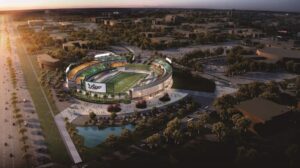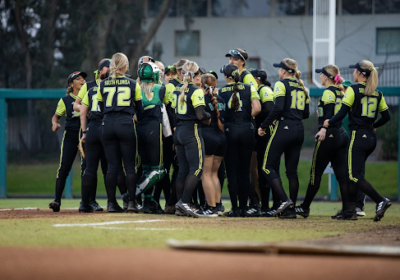On-campus stadium planning committee discusses location, impact of stadium

Vice President of Athletics Michael Kelly anticipates a completed on-campus stadium by fall 2026 as he and Senior Vice President of Advancement and Alumni Affairs Jay Stroman lead its planning committee.
In a Dec. 7 Board of Trustees (BOT) meeting, Stroman introduced the sub-committees, including site location and design, revenue and finance, communications and marketing and legal.
Kelly said the stadium is currently in the pre-planning phase, which typically lasts about a year to a year and a half.
Afterward, there will be a design phase which is an 18-month to two-year project, according to Kelly. The construction usually takes about two years.
“Rarely does any project from this initiative ever take less than five years,” Kelly said. “That’s why we’ve kind of realistically targeted anywhere between 2026 fall and the 2028 fall as being when we envision this coming to reality.”
Four possible locations have been proposed since 2016, according to Kelly, including the southwest corner of campus near Bruce B. Downs Boulevard and Fowler Avenue, the intramural fields near Juniper-Poplar, the Museum of Science and Industry site and Fowler Fields.
In the BOT meeting, Kelly introduced a fifth possible location — Sycamore Fields. He said the new option would be considered due to its proximity to the Athletics district and on-campus student housing.
“[Originally] there was not [a location] that was identified right within the Athletics district, and so that’s come into play now with some land adjacent to … the Lee Roy Selmon Athletic Center,” Kelly said.
While no location has been decided yet, the committee will evaluate different locations this semester and one must be finalized by July.
The funding plan and cost of the stadium are still unknown, but will need to be determined based on what is feasible for the university. For the type of stadium he has in mind to meet the university’s needs, Kelly expects it to be between $150 to $300 million.
The committee will determine the funding sources which may also influence the price of the stadium. However, much of it could come from philanthropy and “dedicated resources that would come from the ultimate use of the facility.”
“[Revenue streams associated with ownership is] kind of the big reason as to owning a stadium as opposed to renting,” Kelly said. “You then now have all the revenue streams [coming from] naming rights for the facility, the concessions revenue, the parking revenue [which will] pay for the building ultimately.
“There’s still some work to be done and depending on if there’s other uses of the facility that have an academic mission or purpose to it as well or a health mission or purpose could also be able to be included in the facility.”
A student contribution to the funding is still uncertain, but on-campus stadiums typically require some sort of student funding.
“This is ultimately a, in my opinion, a campus life enhancement for the long term for the university,” he said. “Ultimately, what the students and the campus feels about it and the use of it and how they can do certain fees are an important part of it. So that remains to be seen.
“But [student contribution is] not uncommon for some recent campus stadiums. When there’s been interest, we anticipate to have that as a potential funding source.”
The communications sub-committee will begin focus groups in the spring semester, which will serve to find what students, alumni, donors and investors will want out of the stadium, including social areas and different seating options of varying prices such as suites, club seats or standard seating.
“You have to just design it to try to meet everybody’s needs, but that’s what will be fun,” he said. “Instead of making an existing facility workforce, we have a chance as a community to design it exactly what students think is cool for them.”
To tailor to student and different departments’ needs, the stadium will likely have multiple uses, other than home games.
“We have to identify what we need as a university and what else we would want in that facility,” Kelly said. “You want to have it be, mentally, a place for athletics, but potentially for concerts and other events that the campus community brings to the area.
“If it becomes something that the student body in the Tampa Bay community uses day in, day out, it just kind of creates more vibrancy around the facility.”
Kelly said he hopes the stadium allows the university to build a better sense of community in the area, something that can be made difficult with an off-campus stadium.
Attracting alumni to return to campus, as well as making it more accessible for the student body to attend, would increase engagement and attendance at the games and allow students to become more involved in the Athletics department, according to Kelly.
Although the stadium is still in the early development stages, Kelly said the lasting impact it will have once completed will mark a unique and rewarding experience for the USF community and everyone involved.
“When you keep coming back for years to come, you’ll know that you were part of the class to make that happen,” he said. “You finally get to take a look at where you stand in history. So this is an exciting time for the campus community.”






